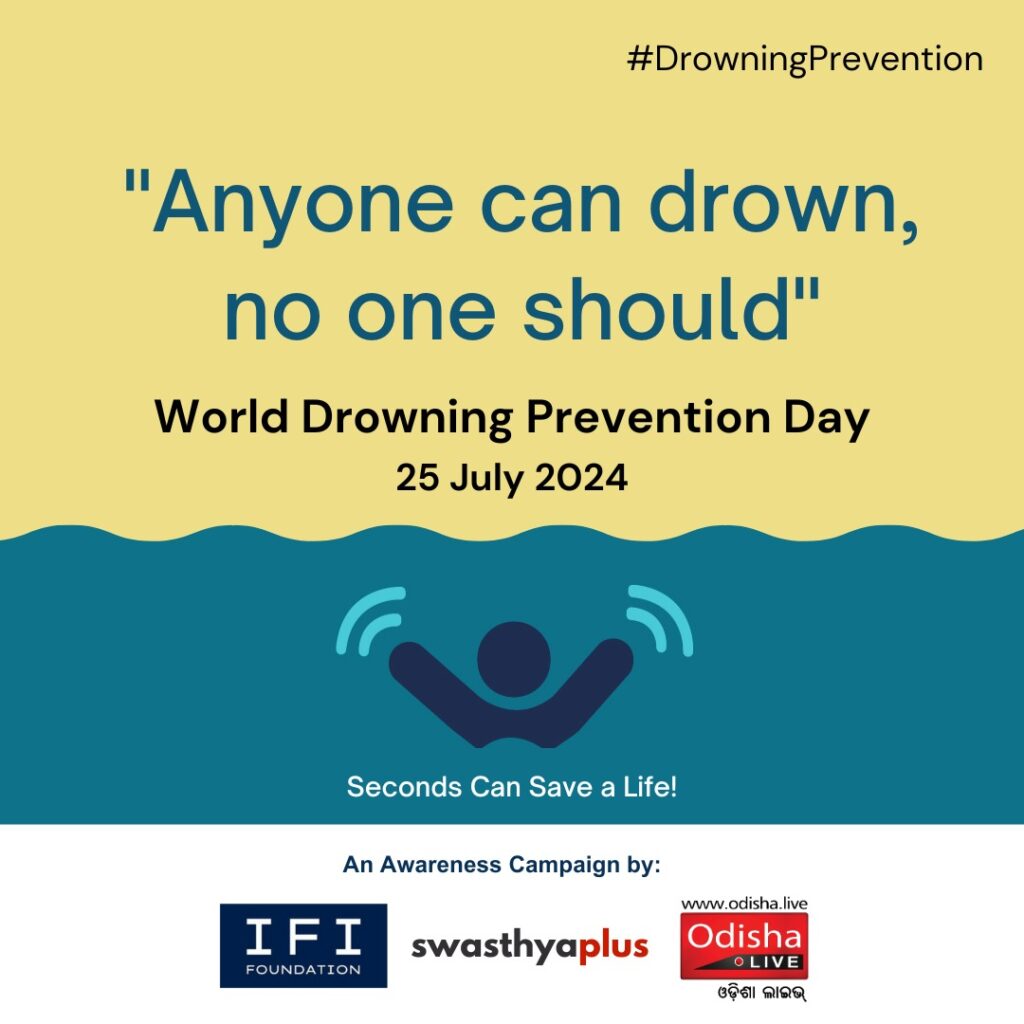World Drowning Prevention Day (25 July) Highlights – ‘Anyone can drown, but no one should’
Nilambar Rath, Sriram Singh Rattan & Prachi Tanaya Behera

Couple of years back when senior TV journalist Arindam Das lost his life while reporting live from an overflowing Mahanadi stream, it was a big shock for the media fraternity in Odisha and outside. Arindam fell into the raging waters and drowned resulting in the untimely demise of a young dynamic Indian journalist.
As per World Health Organization (WHO), drowning, a preventable tragedy, takes over 2,36,000 lives annually worldwide. This makes drowning one of the leading causes of unintentional deaths. As we observe World Drowning Prevention Day on July 25th, it’s time to dive deep into this critical issue and explore how we can turn the tide on this global epidemic.
Drowning doesn’t limit itself to any age. It causes numerous deaths across age groups right from young children to adolescents, youth and beyond. Mostly, drowning can be attributed to common causes like lack of attention to kids and young children, thrill of the youth, alcoholism and negligence across cases. So, with care and awareness we can deal with this preventable tragedy.
“Drowning is always sudden, silent and shocking, with people often not realizing it’s happening until it’s too late. Lives are lost in a single moment. But with right awareness and actions, lives can be saved in that single moment. Drowning is preventable. Anyone can drown, but no one should. We must act to make this happen. Let’s act to prevent drowning, one action, one life at a time,” says Dr. Roderico H. Ofrin, WHO Representative to India, in a message highlighting the urgency of this issue.
Imagine a disaster that claims so many lives each year yet often goes unnoticed in the headlines. This silent killer lurks in our oceans, lakes, rivers, and even bathtubs, striking swiftly and indiscriminately.
Take the example of Om Prakash Rath, a social media influencer from Odisha who drowned in the lush blue waters of the Tapang quarry. The influencer who visited the site along with his friends slipped into the water while busy recording Reels. His body was recovered a few days later. This illustrates how a joyous moment can turn into tragedy in a moment’s negligence. The Tapang quarry has taken many lives due to similar drowning incidents.
The unnatural death of popular bollywood actress Sridevi was a burning case of drowning. She was found dead in the bathtub of her luxury hotel room in Dubai while on a family vacation. Though her death was shrouded in mystery, the police investigation termed it as a drowning incident.
The United Nations General Assembly, recognizing the urgent need for action, established World Drowning Prevention Day in 2021. This annual observance serves as a powerful reminder of the devastating impact of drowning and the crucial importance of prevention strategies.
Thus it’s a day to reflect, educate, and mobilize communities worldwide in the fight against this often-overlooked public health threat.
As per the World Health Organization (WHO), the total deaths due to drowning are not just the staggering number of lives lost each year; it’s also the disproportionate effect on vulnerable populations. Low and middle-income countries bear the brunt of this burden, accounting for over 90% of unintentional drowning deaths. Children and young adults are particularly at risk, with drowning ranking as the third leading cause of death for those aged 5-14 years globally.
What makes these statistics even more heartbreaking is the speed at which drowning can occur. It’s often a silent, rapid event that can claim a life in as little as 20-60 seconds. Often the victims don’t get a chance to realize their peril or get a chance to save themselves. Sadly, they fall prey to drowning in front of their friends and family amidst a happy atmosphere by crossing the safety line. This underscores the critical importance of prevention and immediate response to drowning.
The impact of drowning extends far beyond the immediate loss of life. For every drowning fatality, many more individuals experience non-fatal drowning incidents, which can lead to severe, life-altering consequences. Survivors may face long-term physical and psychological effects, including brain damage, memory problems, learning disabilities, and post-traumatic stress disorder, highlights WHO.
Moreover, drowning incidents create ripples that affect entire communities. Families lose loved ones, often breadwinners or caregivers, leading to emotional trauma and economic hardship. The cost to healthcare systems and society at large is substantial, encompassing emergency responses, medical treatment, and long-term care for survivors with permanent disabilities.
The good news is that drowning is preventable, and there are proven strategies to reduce its incidence. WHO promotes a range of interventions that have shown effectiveness in various contexts:
- Installing barriers: Properly fencing pools and controlling access to water bodies can significantly reduce drowning risk, especially for young children.
- Providing safe spaces: Creating supervised, safe play areas away from water for pre-school children can prevent unsupervised water access.
- Teaching water safety: Implementing school-based programs to teach children basic swimming and water safety skills is crucial.
- Training in safe rescue and resuscitation: Educating bystanders in safe rescue techniques and cardiopulmonary resuscitation (CPR) can save lives in emergencies.
- Enhancing boating safety: Setting and enforcing regulations for safe boating, shipping, and ferry operations is essential, especially in areas reliant on water transport.
- Improving flood risk management: Developing comprehensive strategies to mitigate flood risks and enhance community preparedness can reduce drowning during natural disasters.
It might be the right occasion to recall the Chilika Boat Tragedy which took many lives including women and small children. The tragedy happened when a country boat capsized into the turbulent waters of the Chilika Lake. The investigation revealed that the passengers being ferried in the boat were not wearing life jackets, though it was a protocol for water transport. So, a failure in the safety measures can lead to multiple deaths in a fraction of seconds which should not be termed as mere accidents and overlooked.
As we observe World Drowning Prevention Day 2024, it’s clear that addressing this global challenge requires collective action. From individuals learning basic water safety to governments implementing comprehensive prevention strategies, everyone has a role to play.
By raising awareness, implementing evidence-based interventions, and fostering collaboration at all levels, we can significantly reduce the global burden of drowning. Let this day serve as a catalyst for action, inspiring communities worldwide to create safer aquatic environments and ensure that water remains a source of joy and recreation, not tragedy.
Anyone can drown, but no one should.
Tags: #DrowningPrevention #WorldDrowningPreventionDay #Drowning
(The authors are communication professionals. Views expressed are personal.)


























The most important part is realisation of the danger. So, awareness will definitely help in minimising the death tolls caused due to drowning. At the same time all efforts should be made by the family and institutions to provide training for swimming. That will help to save hundreds of lives.
A good article.
Thank you Dr Fakir Mohan Nahak for your feedback.